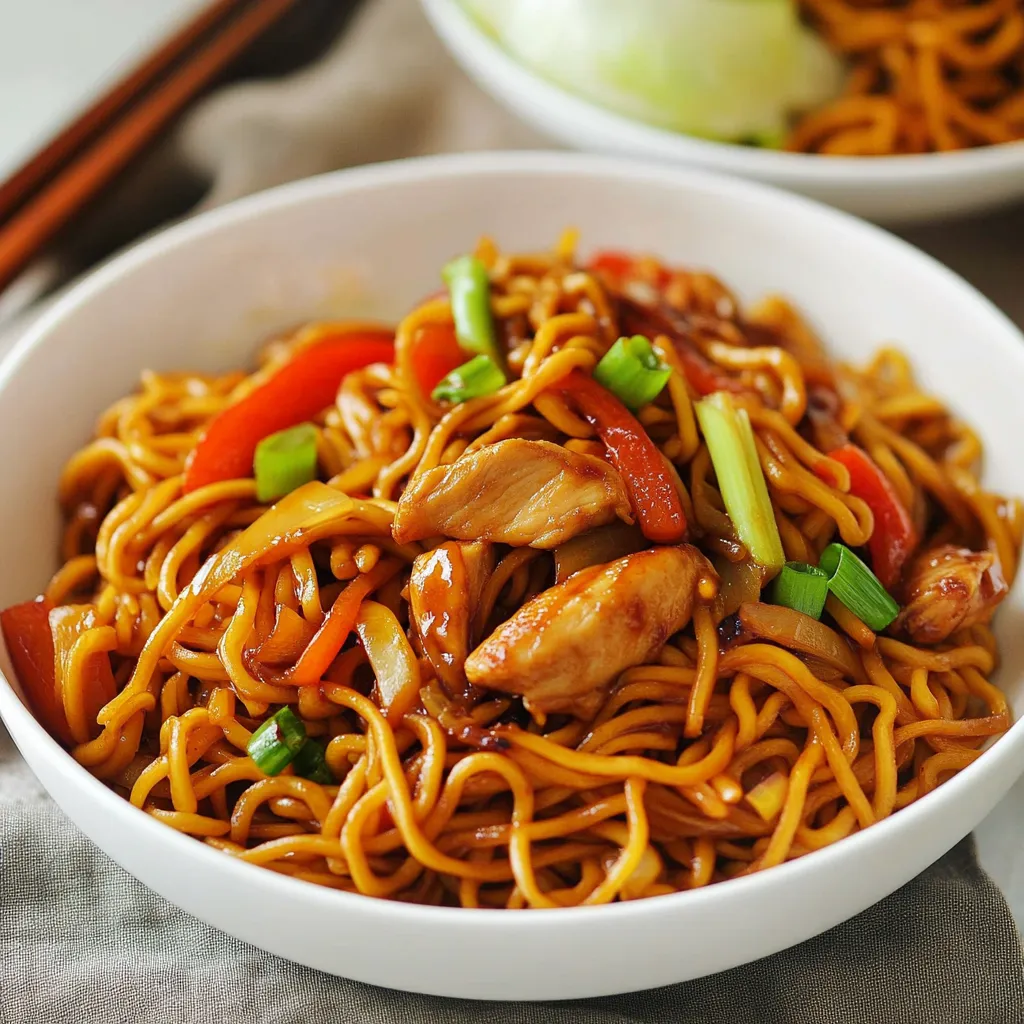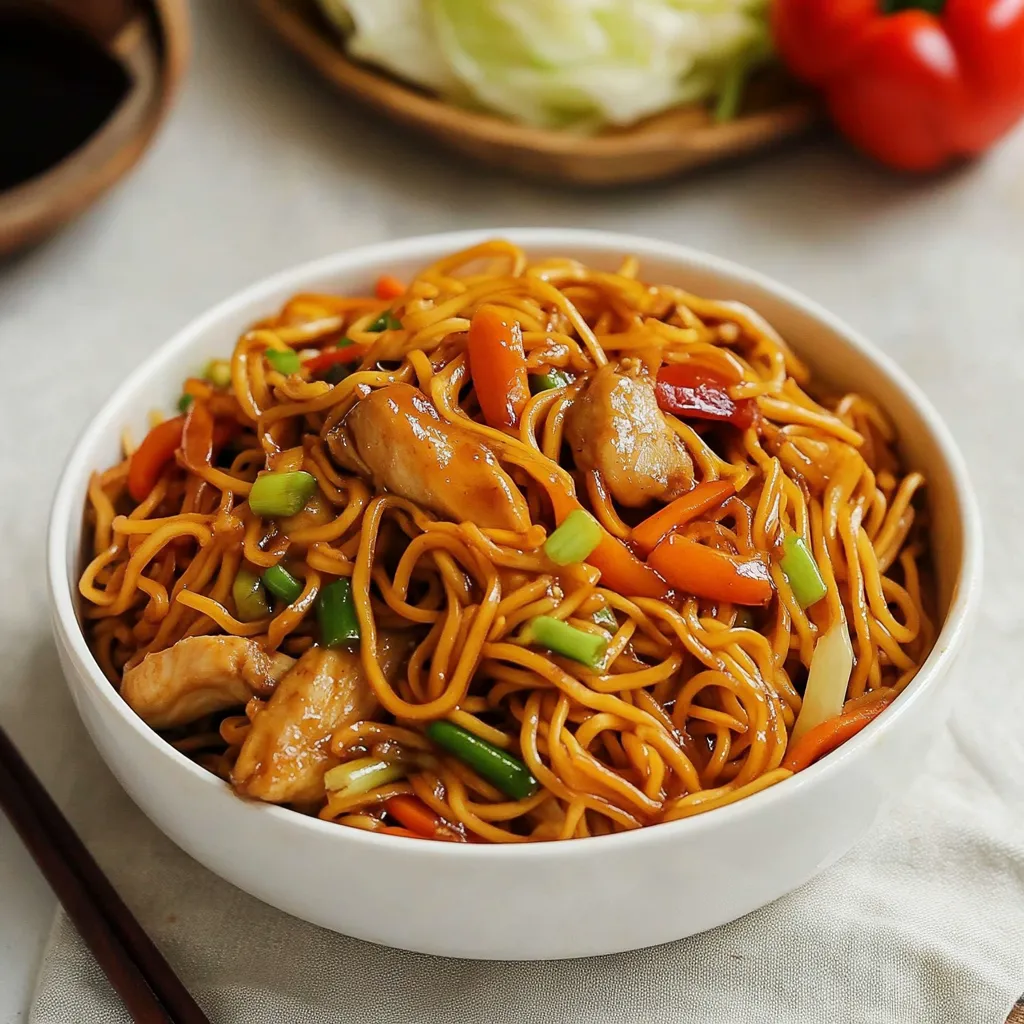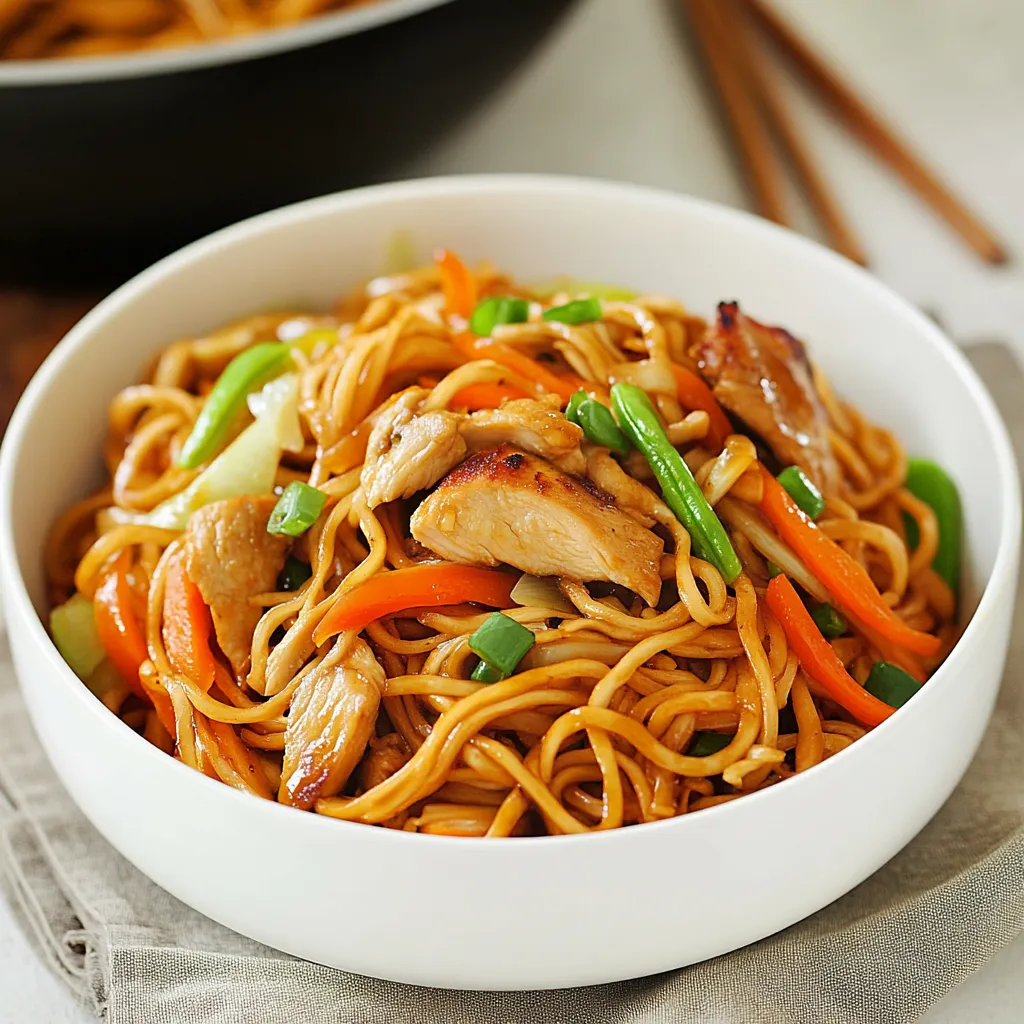 Pin it
Pin it
Piping hot egg noodles mixed with juicy chicken slices and loads of colorful veggies make for a truly crave-worthy dish that packs your table with those classic Chinese tastes. You’ll get all the punchy flavors you love from your favorite takeout, but using crisp fresh goodies and a smooth sauce that hugs every noodle. After loads of trial and error playing with different tweaks, I finally dialed in that magic restaurant vibe without making the steps tricky at all.
I first saw what game-changing noodles could do while hanging out in a busy Hong Kong cooking class. The older chef showed us how pulling noodles a bit early leaves them perfectly springy for stir frying. Before that, my homemade tries turned soggy most times. After this, my people honestly ask for my version instead of takeout! Plus, I can toss in whatever veggies everyone likes.
Tasty Key Ingredients
- Green onions: Slice these up for a fresh pop right at the end—they really wake up the whole meal when you toss them in at just the right time.
- Oyster sauce: That sweet, briny kick is pure magic and absolutely clinches the real Chinese umami—there’s nothing quite like it.
- Dark soy sauce: This gives a deep glossy color and a warm touch of caramel that makes your sauce seriously interesting.
- Egg noodles: These chewy yellow strands are what it’s all about—they soak up all that saucy goodness without falling apart.
- Napa cabbage: Makes everything taste sweeter and crunchier, and soaks up just enough sauce while staying firm.
- Boneless chicken: Sliced thin, this soaks up all your marinade and cooks fast so it’s juicy and tasty after a quick stir fry.
- Bell peppers: These add brightness, crunch, and a hint of sweet tang that balances everything out.
- Fresh carrots: Big on color and a bit of sweetness, plus they keep their bite even with quick cooking.
- Light soy sauce: Helps all the other flavors shine through with just enough salty flavor, nothing overpowering.
How to Make It
- Sauce Mix:
- Stir up three tablespoons light soy sauce, a tablespoon of dark soy, two spoonfuls of oyster sauce, a teaspoon each of sesame oil and sugar, half a teaspoon white pepper, and three tablespoons water right in a measuring cup. Whisk till the sugar disappears and the sauce is smooth—makes for a no-fuss pour when things get sizzling.
- Veggie Chopping:
- Peel and cut two medium carrots into skinny matchsticks, about two inches long. Slice half a small cabbage into half-inch strips (ditch the tough core). Cut your bell pepper the same size as the carrots so they cook even. Chop your green onions on a diagonal into inch-long pieces—split up the white and green parts. Smash and mince three garlic cloves so you get all the flavor in a flash.
- Noodle Prep:
- Boil up a pot of water, drop in eight ounces dried egg noodles, and let them go for exactly two minutes less than the packet says. You want them with some bite—they’ll cook more in the wok. Rinse under cold water so they stop cooking, shake ‘em up with your fingers so they don’t stick, then drizzle with a teaspoon sesame oil and toss gently.
- Chicken Marinating:
- Slice up a pound of boneless chicken breast thin (quarter inch or so, against the grain for tenderness). Drop them in a bowl with a tablespoon light soy sauce, a teaspoon each of sugar and cornstarch, half a teaspoon each baking soda and white pepper, and another teaspoon sesame oil. Work the mix in with your hands so it gets a bit tacky and everything’s coated. Cover and chill it for fifteen minutes while you chop veggies and get the rest ready.
 Pin it
Pin it
My grandma used to swear the wok had to be super hot before tossing anything in—I used to think she was just being picky. Turns out, heating it till just a wisp of smoke rises gives your dish that unbeatable, smoky 'wok hei' taste you only get at restaurants. When I treated myself to a real carbon steel wok and learned to heat it right, my chow mein tasted miles better—richer flavors and that slight crisp finish every time.
Easy Serving Ideas
Scoop your chicken chow mein onto a big plate so everyone can dig in together. Set out bowls of extra chili oil, soy sauce, or chopped cilantro so folks can tweak it how they want. Or, if you’re splitting into single bowls, sprinkle on some toasted sesame seeds and green onions for a pretty—and tasty—finish.
Switch It Up
If you want to skip the chicken, just swap in extra firm tofu (pressed and marinated the same). Pick whatever veggies you’ve got in your fridge—snow peas, mushrooms, or zucchini all work well. Fancy some heat? Add a spoon of chili oil or sliced fresh chilies while stirring everything together near the end.
Leftovers Made Simple
Throw whatever’s left in a container with a lid and stick it in the fridge—good for three days. To heat it back up, toss it in a skillet on medium-high with a splash of water and a drizzle of oil, moving it around so it all warms evenly. Try not to use the microwave; you don't want mushy noodles.
 Pin it
Pin it
Stirring up chicken chow mein at home makes me feel part of a long chain of cooks, and there’s nothing like nailing those classic tastes with just some good moves. When the noodles hit the sauce in that final flip, the whole thing just comes alive. Sure, it asks for a bit of timing and juggling, but it totally beats most takeout thanks to fresh stuff and little tweaks you pick. When you see everyone happily slurping, you get why sharing this dish always just feels good.
Frequently Asked Questions
- → How do you keep chicken soft in chow mein?
- You want to marinate thin chicken strips with a bit of cornstarch, soy sauce, and a tiny splash of baking soda. Baking soda tenderizes, and the cornstarch locks in moisture, so the chicken stays juicy even with high heat.
- → Can I swap out the veggies in chow mein?
- For sure! Use what you like—mushrooms, snow peas, broccoli, baby corn, or bean sprouts all work. Toss in firmer veggies first and save the fragile ones for last so they don’t overcook.
- → How are light and dark soy sauce different?
- Light soy sauce makes things salty and flavorful but doesn’t add much color. Dark soy sauce is thicker, a little sweet, much deeper in color, and less salty. Mixing both makes for good looks and bold taste.
- → Can I use other proteins if I don’t have chicken?
- Totally. Try pork, beef, shrimp, or tofu. Beef or pork can use the same marinade. Shrimp just needs a quick 5-minute soak. With tofu, just dust it in cornstarch and fry—skip marinating.
- → Why rinse the noodles in cold water after boiling?
- Rinsing with cold water stops cooking fast, so your noodles don’t get mushy. It also gets rid of extra starch, meaning your noodles stay loose for easy stir-frying.
